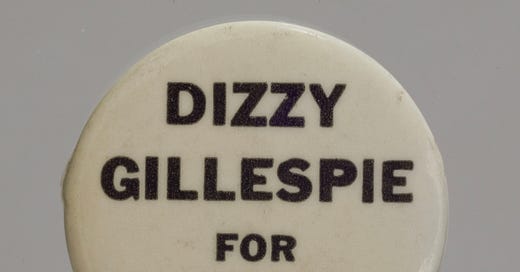Dizzy Gillespie for President
The true story of the 1964 write-in campaign by Bebop legend John Birks “Dizzy” Gillespie
Campaign button. Courtesy Wikimedia.
For all you that understand the need for and the power of independent politics in the United States, the master of the trumpet John Birks “Dizzy” Gillespie, who was aiming bebop towards the center of jazz, provides a testimony that is more inspiring and compelling than amusing. It was significant enough to gain its own Wikipedia page!1More to the point, though, it was at once both a cultural and political statement of and for the Civil Rights Movement (CRM) and was an early sign of joining it with the movement to end the Vietnam War.
Having risen during the organizing for the March on Washington for Jobs and Freedom in 1963, the campaign was a casual affair with serious undertones. While buttons and balloons were central to spreading the message of the presidential run, Dizzy’s campaign speeches were often part of spoken segments in his concert routines from 1963 to 1964.
As Gillespie wrote in his autobiography, the campaign, conceived as the CRM was becoming a threat to official segregationism, had concrete political goals, including civil rights protections, an end to the Vietnam War, and recognition of the People’s Republic of China. The buttons were sold to raise funds for the CRM organizations Congress of Racial Equality and the Southern Christian Leadership Conference, the latter co-founded by Dr. Martin Luther King Jr.
The most fascinating part of his run for a Blues House was his choices for a cabinet. Imagine, if you would, a “Shadow Cabinet” like this:
Secretary of State: Edward Kennedy “Duke” Ellington
Director of the Central Intelligence Agency: Miles Davis
Secretary of Defense: Max Roach:
Secretary of Peace: Charles Mingus:
Secretary of Labor: Peggy Lee
Librarian of Congress: Ray Charles
Secretary of Agriculture: Louis Armstrong
Ambassador to the Vatican: Mary Lou Williams
Traveling Ambassador: Thelonious Monk
Attorney General: Malcolm X (El Hajj Malik El Shabazz):
Note well that among peace activists, a Department of Peace has been a long campaign in progress. Dizzy’s opposition to the war in Vietnam, therefore, was firmly at the center of his campaign.
Interestingly, he was also prescient about US relations with Vatican City, as an ambassador would ultimately be appointed in 1984.
Mixing art with a presidential campaign itself found a spiritual successor in 1968, when human rights stalwart and comedian Dick Gregory ran on the Freedom and Peace Party. Like the Peace and Freedom Party - and Gillespie’s campaign - that preceded it, it was driven by demands from the Civil Rights and antiwar movements.
Two fascinating facts are worth noting. In1968, Gregory was active in the work of Dr. King’s original Poor People’s Campaign (PPC) and Gillespie performed for the residents of Resurrection City, its protest camp in Washington, DC.
Three years later, in 1971, Dizzy charted another brief road to the White House, which he said he would rename the Blues House. Among his cabinet choices this time was Muhammad Ali for Secretary of State.
One lesson that resonates to the present day is the tremendous need for politics independent of entrenched “party” systems. Dizzy’s run, like the best independent campaigns in history, were truly reflective of the struggles for peace and justice. Power only ever made concessions when agitation from the grassroots demanded them, with the full force of their numbers. Artists who dare to tell the truth have always been, and always must be, counted among them.
And no matter where it is, struggle needs a home in a Blues House.
Dig?
John Birks “Dizzy” Gillespie (21 October 1917 – 6 January 1993), ¡Presente!
Sources
https://web.archive.org/web/20090114235533/https://www.bbc.co.uk/radio4/factual/pip/4y7yo/?focuswin
https://www.vanityfair.com/news/story/dizzy-gillespie-for-president-1964-campaign
https://www.indianapublicmedia.org/nightlights/before-colbert-there-was-dizzy-gillespies-1964-run-for-the-presidency.php
https://en.m.wikipedia.org/wiki/Dizzy_Gillespie_1964_presidential_campaign




I had no idea about this campaign! Absolutely amazing story. Thanks, Angel! 💫